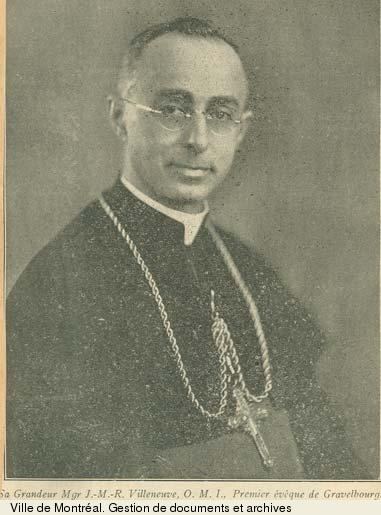See Quebec Created cardinal March 13, 1933 | ||
 | ||
Installed December 11, 1931—January 17, 1947 Other posts Previously Bishop of Gravelbourg Name Jean-Marie-Rodrigue Villeneuve Predecessor | ||
Jean-Marie-Rodrigue Villeneuve, OMI (November 2, 1883 – January 17, 1947) was a Canadian Cardinal of the Roman Catholic Church. He served as Archbishop of Quebec from 1931 until his death, and was elevated to the cardinalate in 1933.
Contents
Early life and ordination
Jean-Marie-Rodrigue Villeneuve was born in Montreal, one of the three children of a shoemaker. He completed his secondary studies at Mont-Saint-Louis, from where he obtained a diploma in science and commerce, in 1900. After teaching at a school in Dorval, Villeneuve entered the Oblates of Mary Immaculate on August 14, 1901, in Lachine. He professed his final vows on September 8, 1903, and was ordained to the priesthood by Archbishop Joseph-Thomas Duhamel on May 25, 1907. While pursuing doctoral studies at the University of Ottawa, Villeneuve taught philosophy (1907–1913) and moral theology (1913–1920) at the Oblate Scholasticate in Ottawa. He also served as a professor of canon law, liturgy, spirituality, and ecclesiastical history, and the Dean of Theology at the Scholasticate.
Professor
From the University of Ottawa, he earned a doctorate in philosophy (1919), doctorate in theology (1922), and doctorate in canon law (1930). Villeneuve founded the School of Superior Ecclesiastical Studies, where he was made titular professor of canon law, in 1928. In 1929, he returned to the University of Ottawa, this time to head the Canon Law Faculty. He was active in labor unions, civil rights, and contributed to Le Droit.
Bishop and Archbishop
On July 3, 1930, Villeneuve was appointed the first Bishop of Gravelbourg by Pope Pius XI. He received his episcopal consecration on the following September 11 from Archbishop Joseph-Guillaume-Laurent Forbes, with Bishops Louis Rheaume, OMI, and Joseph Guy, OMI, serving as co-consecrators, in the Cathedral of Ottawa. Villeneuve was later named Archbishop of Quebec on December 11, 1931.
Cardinal
Pius XI created him Cardinal-Priest of S. Maria degli Angeli in the consistory of March 13, 1933. Commenting on his elevation, Villeneuve said, "I do not feel at all worthy, but the Sovereign Pontiff calls me and I go." The Canadian primate was one of the cardinal electors who participated in the 1939 papal conclave, at which he himself was considered papabile, that selected Pope Pius XII.
Later life and death
Villeneuve was stricken by a heart attack on July 7, 1946, while returning from Ile-a-la-Crosse, where he had taken part in the celebrations for the centennial of his order. After being hospitalized at Hotel-Dieu de Quebec, he left Quebec for the United States, specifically for Misericordia Hospital in Manhattan, on the following October 4 for medical treatment, having yet another crisis on October 14.
Seeking a milder climate, he arrived at a convent in Alhambra, California, on January 14, 1947. Three days later, the Cardinal stopped his private secretary during the beginning of the latter's Mass, sensing his death was imminent. He died within the hour, at 7:50 a.m., aged 63.
Upon his body's return to Canada, flags were set at half-staff. On January 24, Cardinal James Charles McGuigan celebrated his funeral Mass, at which, according to Villeneuve's will, there was no eulogy but only Gregorian music. He is buried in the Cathedral-Basilica of Quebec.
Modern freedoms
He was opposed to freedom of the press, of thought, and of religion, and believed that granting women the right to vote would have ruinous effects on family unity and paternal authority.
Wearing shorts
He viewed wearing shorts as an offense to Christian decency. He became known in Quebec as its "Good Father".
Conscription
Initially an isolationist, he encouraged French Canadians to register for the draft and to enlist upon the outbreak of World War II, saying, "You cannot fight this war by condensing the horizon to this continent." During the fall of 1944, he visited the Canadian military stationed in Great Britain, Italy, Belgium, and the Netherlands.
